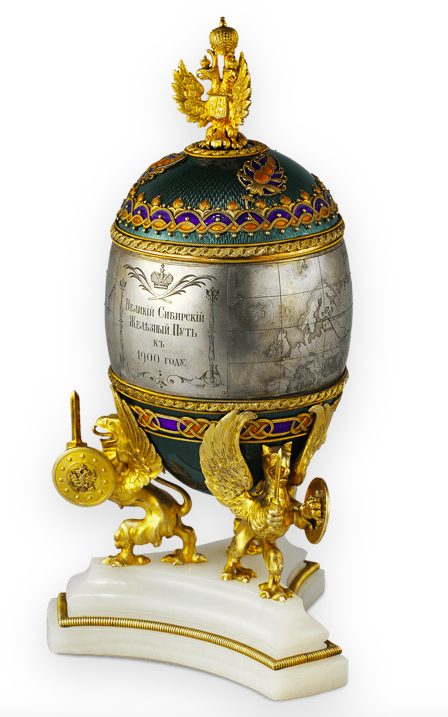1900 The Trans-Siberian Railrway Egg
Alexandra Feodorovna
Purchase price 7,000 rubles.
It was a long-cherished dream of the Emperor Alexander III to link the European and the Asian halves of the Russian Empire by a rail line. The Grand Siberian Railroad was seen as a project of great political significance, its construction overseen by a special committee, chaired by the crown prince Nikolai Aleksandrovich. The grandiose undertaking was accomplished in
a fairly short time: by 1900 one could travel non-stop along the entire Siberian railway. The arrival of the Trans-Siberian railway spurred on the settlement and development of boundless, half-empty territories by millions of frontiersmen. The Easter egg of 1900, presented to the Empress Alexandra Fedorovna, celebrated this epoch-making achievement, and was showcased at the Paris World’s Fair in the same year.
From an entry in the “Inventory of items, belonging to Their Imperial Majesties and kept in their private quarters at the Winter Palace”: “Silver egg, resting on a pedestal of white onyx, triangular in shape, applied with a reeded fringe of gilded silver. The pedestal supports three golden griffons, who hold up the Egg with their wings. The middle section of the Egg is made of silver-plated metal, engraved with a map of Siberia. In the middle of the map is a panel bearing the engraving “The Great Siberian Railway in the year 1900” topped with a crown. The bottom edges of the lid and the middle section are applied with borders of green and red gold. At the top of the egg stands a three-sided figure of the eagle, bearing a crown, made of gilded silver. The interior of the Egg is lined with velvet and holds a miniature replica of a train: five railcars with a locomotive and a tender. The carriages and the tender are made of gold, while the locomotive is of platinum. The model may be set in motion by means of a gold key.”
The masterfully executed miniature locomotive — just under 2 cm in length — with a ruby lantern and diamond headlamps, pulls along a train of five railway carriages with windows of rock crystal. The coaches bear inscriptions: “Direct service to Siberia,” “Ladies only,” “Smoking,” and “Non-smoking,” respectively, along with the number of seats (18 and 24) and the designation of 1st- or 2nd-class carriage. Closing out the train is a chapel-car, modeled on an actual traveling chapel, built in 1896 and dedicated — in the presence of the Imperial family — to St. Olga, namesake saint of the Emperor’s eldest daughter.
In the collection of the Kremlin Armory Museum, Moscow, RF.
